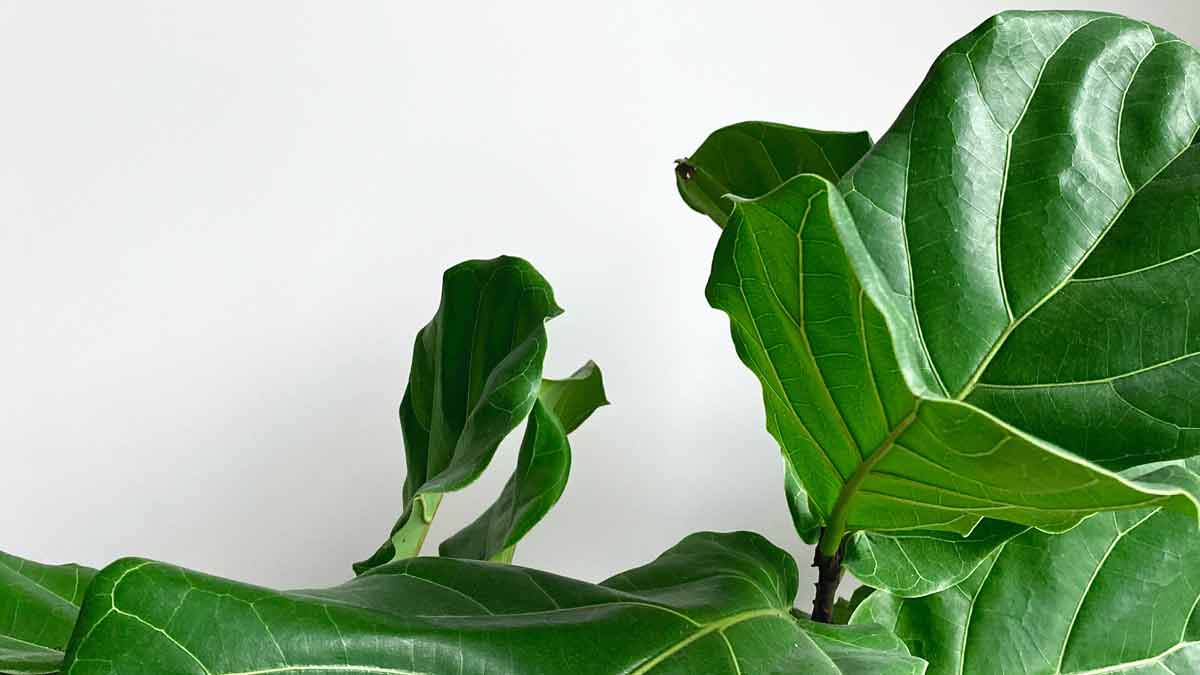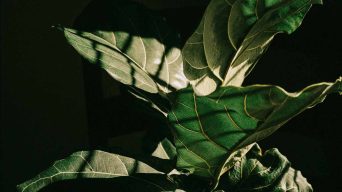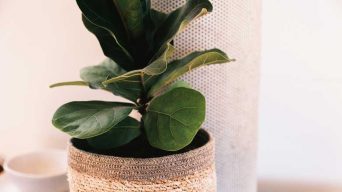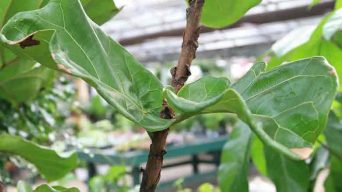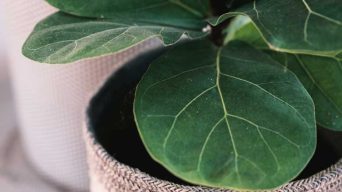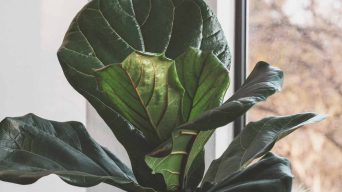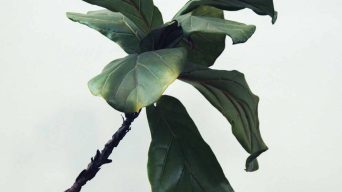To keep your fiddle leaf fig plant healthy, provide it with ample natural light, water when the top soil is dry, maintain 50% humidity with a humidifier, keep it in a consistent well-lit spot, use well-draining soil, fertilize with fish emulsion 5-1-1 during the growing season, and perform monthly leaf cleaning and pest inspections.
Doting over your fiddle leaf fig only to find it wilting can be heart-wrenching for any plant lover. But fret not!
Our handy guide packed with easy-to-follow tips and maintenance advice will transform you into a green-thumbed caretaker of this exotic beauty.
Whether it’s about decoding the right light conditions or nailing the perfect watering schedule, this guide will equip you with all the essential tools and insights to ensure your Fiddle Leaf Fig survives and thrives in its lush, green glory.
Get ready to embark on an exciting journey that brings you one step closer to cultivating your personal indoor jungle.
Facts and Statistics
- Research suggests that fiddle leaf figs respond best to indoor temperatures around 70°F – 75°F during the day and no cooler than 65°F at night.
- A proper watering regimen for a fiddle leaf fig involves letting the soil dry out between waterings, which, according to horticulture studies, is typically every 7-10 days in average room temperature conditions.
- Studies indicate that for optimal health, fiddle leaf fig trees require approximately 6 hours of indirect light per day.
Understanding Fiddle Leaf Fig Characteristics
Before diving into the essential care steps for your beloved fiddle leaf fig, it’s crucial to understand the characteristics of this popular houseplant.
By familiarizing yourself with its nature, you’ll be better equipped to provide the proper care and create an optimal environment for your plant to thrive.
The fiddle leaf fig, scientifically known as Ficus lyrata, is a tropical tree native to West Africa.
Its unique foliage, resembling a violin or fiddle, has earned it its distinctive name. With large, glossy leaves that can grow up to three feet long, this plant adds elegance and drama to any indoor space.
Imagine walking into a room filled with lush greenery surrounding a tall, majestic fiddle leaf fig. Its broad leaves create a sense of tranquility and provide a focal point for the room.
This magnificent plant has become increasingly popular among houseplant enthusiasts due to its aesthetic appeal and ability to bring joy to people’s lives.
To ensure you’re giving your fiddle leaf fig the care it deserves, it’s important to recognize both healthy and unhealthy signs in its growth and appearance. Let’s explore how to identify these indicators.
Recognizing Healthy and Unhealthy Signs
Healthy fiddle leaf figs exhibit certain traits that indicate their well-being.
Look out for large and strong new leaves emerging from the branches; these are signs of a thriving plant. In contrast, small and stunted new leaves may indicate a lack of nutrients or other underlying issues.
If you notice slow or stunted growth in your fiddle leaf fig, consider repotting it with fresh soil or providing extra nutrients through fertilization during the spring and summer seasons.
Picture this: Your fiddle leaf fig boasts abundant new growth every 4-6 weeks during spring and summer. T
he vibrant green hues of fresh leaves captivate your attention, filling you with a sense of pride and satisfaction. This growth signifies a healthy and well-nourished plant ready to take on the world.
On the other hand, unhealthy signs can manifest in various ways, including brown spots on the leaves, dropping leaves, or leaves turning yellow.
These signs often indicate underlying issues that require attention.
Brown spots that start in the middle of the leaf and spread outwards are likely caused by overwatering and root rot.
On the contrary, brown spots that start on the edge of the leaves and spread inward are typically caused by under-watering.
Additionally, random brown spots might appear due to trauma from changing environments.
When older leaves begin to fall off first, it’s usually a sign of overwatering. In contrast, if leaves drop from all over the plant without a specific pattern, it may indicate under-watering.
Yellow leaves can result from insufficient light, poor nutrition, or pest infestations. Ensure that your fiddle leaf fig receives enough bright indirect light throughout the day.
Consider feeding it with liquid fertilizer to provide necessary nutrients and check for any signs of insect infestation.
Understanding these healthy and unhealthy signs will help you assess your fiddle leaf fig’s well-being more effectively.
By observing its growth and appearance closely, you can promptly address any issues that arise and provide appropriate care to ensure a healthy and thriving plant.
Now that we have explored how to recognize healthy and unhealthy signs in your fiddle leaf fig, let’s move on to the essential care steps required for its optimal growth and maintenance.
Essential Fiddle Leaf Fig Care Steps
When it comes to ensuring the health and vitality of your beloved Fiddle Leaf Fig plant, several essential care steps should be followed.
By paying attention to these steps, you can create an optimal environment for your plant to thrive.
First and foremost, make sure to choose the right potting soil. Fiddle Leaf Figs prefer a well-draining soil mix that allows water to flow freely, preventing moisture from accumulating and causing root rot.
A combination of good quality potting soil, perlite, vermiculite, and organic compost works well. This fluffy and airy mix promotes proper drainage while retaining enough moisture for the plant’s roots.
Watering is a critical aspect of Fiddle Leaf Fig care. Unlike some plants that require regular watering schedules, Fiddle Leaf Figs need to be watered when the top inch or two of the soil feels dry.
Stick your finger into the soil to test its dryness before watering.
Avoid overwatering as this can lead to root rot, one of the most common causes of decline in these plants.
It’s also important to ensure proper drainage in your pot by providing sufficient holes at the bottom.
For example, let’s say your Fiddle Leaf Fig is potted in a 10-inch container.
In warm weather conditions, you might find that the top inch of the soil dries out within a week or so. This would indicate that it’s time to water your plant again.
However, it might take longer for the soil to dry out completely during cooler months or with less sunlight exposure.
Another crucial aspect of care is providing sufficient light for your Fiddle Leaf Fig. These plants thrive in bright indirect light but avoid direct sunlight as it can scorch their leaves.
Place your plant near a window where it can receive bright light throughout the day, preferably facing south if possible.
If natural light is limited, you can supplement with a grow light to ensure your plant gets the necessary light it needs for optimal growth.
Now that we have covered the essential care steps for Fiddle Leaf Fig plants let’s move on to understanding their correct environment and light requirements.
Correct Environment and Light Requirements
Creating the right environment for your Fiddle Leaf Fig is crucial for its growth and overall well-being. These tropical trees thrive in warm and humid conditions reminiscent of their natural habitat.
Here are some key factors to consider:
Temperature plays a significant role in the health of your Fiddle Leaf Fig. Aim for an average indoor temperature between 60-75°F (15-24°C) as these plants prefer moderate warmth.
Avoid exposing them to extreme temperatures or drafts, such as those near air conditioners or heating vents, as it can cause stress and harm their leaves.
Humidity is another critical factor to pay attention to. Fiddle Leaf Figs prefer high humidity levels, which can be challenging to maintain indoors, especially during dry winters or in arid regions.
To increase humidity, you can use a humidifier or place a tray filled with water near the plant. Misting the leaves occasionally also helps mimic their natural tropical environment.
Air circulation is essential for the health of your Fiddle Leaf Fig. Good airflow helps prevent diseases and strengthens the trunk of the plant.
To promote adequate air circulation, avoid placing your plant in cramped corners or areas with limited ventilation. Consider occasional gentle movements or using a fan set on low to improve airflow around your plant.
By providing your Fiddle Leaf Fig with the correct environment and ensuring it receives adequate light, water, and nutrients, you’ll be well on your way to nurturing a healthy and thriving plant.
Water and Nutritional Needs
Proper watering and providing adequate nutrition are vital components of healthy fiddle leaf fig care.
It’s important to understand the specific water requirements and nutritional needs of these plants to ensure their optimal growth and well-being.
First, let’s talk about watering. Fiddle leaf figs prefer a consistent watering routine but without overdoing it. The key is to maintain moist but not soggy soil.
Overwatering can lead to root rot and brown spots on the leaves, while underwatering can cause the leaves to droop and turn brown as well.
To determine when it’s time to water your fiddle leaf fig, check the moisture level in the soil by inserting your finger about an inch deep. If it feels dry at that depth, it’s time to water your plant.
Remember, every environment is different, so adjust your watering schedule accordingly based on factors like temperature and humidity.
Imagine you regularly inspect the soil of your fiddle leaf fig plant, sticking your finger into the potting mix every few days. You notice that the soil feels slightly moist but not saturated. This indicates that your plant has enough moisture for now, so you can hold off on watering a little longer.
In addition to proper watering, ensuring that your fiddle leaf fig receives appropriate nutrition is crucial for promoting healthy growth.
New leaves require an ample supply of nutrients, especially during the spring and summer months when growth is most active.
Providing additional nourishment through fertilization or repotting with fresh nutrient-rich soil can help support your plant’s vitality.
Now that we’ve covered the water and nutritional needs of fiddle leaf figs, let’s move on to another important aspect of caring for these plants: propagating and growing new plants.
Propagating and Growing Fiddle Leaf Figs
Propagating fiddle leaf figs allows you to create new plants from existing ones, providing an opportunity for expansion or sharing the joy of growing with others.
You can employ a few methods to propagate fiddle leaf figs, including stem cuttings and air layering.
The most common method is propagating through stem cuttings. Start by selecting a healthy stem with a few leaves at the top.
Make a clean cut just below a node (where the leaf meets the stem) using sharp, sterile pruning shears. Remove any lower leaves, leaving only those at the top of the cutting.
Next, place the cutting in water or well-draining soil mix and keep it in a warm, bright area with indirect light. Remember to change the water regularly if using this method.
Alternatively, you can dip the cutting in rooting hormone and plant it directly into a small pot filled with a well-draining soil mix.
Think of propagating a fiddle leaf fig like taking a piece of your favorite houseplant and encouraging it to grow into a brand new plant. It’s like making copies of something you love to share with others!
Air layering is another technique for encouraging roots to develop on a stem while still attached to the parent plant. This involves making an incision in the stem and placing a moist sphagnum moss ball around it, securing it with plastic wrap or foil.
The enclosed area should remain warm and humid to promote root growth. Once roots have formed, you can detach the newly rooted section from the parent plant and pot it up.
Remember that propagating fiddle leaf figs requires patience and consistent care as rooting can take several weeks or even months. However, witnessing new growth emerge from your propagated cuttings is incredibly rewarding.
Having discussed proper watering, nutritional needs, and propagating and growing fiddle leaf figs, we’ve covered essential aspects of caring for these magnificent plants.
Safely Starting New Plants
Starting new plants from cuttings can be an exciting and rewarding process for any plant enthusiast, and the fiddle leaf fig is no exception.
By propagating new fiddle leaf fig plants, you can expand your collection or share the joy of growing these beautiful plants with others.
However, it’s essential to follow proper techniques to ensure success.
One method commonly used to start new fiddle leaf fig plants is through stem cuttings. This involves carefully selecting a healthy stem on your existing fiddle leaf fig that has at least 2-3 leaves.
Using a clean, sharp knife or pruning shears, make a diagonal cut just below a node – the point where a leaf attaches to the stem. The cutting should be approximately 6-8 inches long.
Once you have your cutting, remove any leaves from the lower half of the stem. This helps lessen water loss and encourages root formation.
Dip the cut end into rooting hormone powder or gel to stimulate root growth. Then, insert the cutting into a small pot filled with moistened well-draining soil mix, making sure the nodes are covered with soil.
Place the pot in a warm and bright location, but avoid direct sunlight as it can scorch the leaves.
After planting your cutting, misting the leaves regularly can help maintain humidity and encourage root development. It’s important to keep the soil lightly moist but not overly saturated to prevent rotting.
Managing Fiddle Leaf Fig Problems
Like any other living organism, fiddle leaf figs are susceptible to various issues that can affect their overall health and appearance.
Understanding common problems that may arise and knowing how to manage them effectively is key to maintaining thriving fiddle leaf figs.
One particularly prevalent issue is brown spots on leaves, which can indicate overwatering and root rot or under watering.
To address this problem, closely observe the watering habits of your fiddle leaf fig. Ensure that they are getting adequate water but not sitting in standing water. Adjust your watering schedule accordingly and consider using well-draining soil to prevent excessive moisture retention.
Another concern is leaves turning yellow, which can be a result of inadequate light, poor nutrition, or pest infestation.
Fiddle leaf figs thrive in bright indirect light, so make sure they are receiving adequate illumination. If needed, you can supplement with grow lights.
Additionally, regular feeding with a balanced liquid fertilizer and periodic monitoring for pests can help maintain the plant’s health.
Think of maintaining fiddle leaf figs like taking care of your own well-being. Just as you need proper nutrition and a conducive environment to thrive, these plants rely on suitable lighting conditions, appropriate watering practices, and regular maintenance for optimal growth.
While it’s understandable that challenges may arise along the way, it’s important not to get discouraged. Remember that every setback provides an opportunity to learn and improve your plant care skills.
Seek guidance from experienced growers, join online communities to share experiences and gain insights from others facing similar challenges.
Now that we have explored the importance of safely starting new plants and managing common problems with fiddle leaf figs, let’s move on to another critical aspect – preventing diseases and pests that can potentially harm these beloved plants.
Preventing Diseases and Pests
One of the key aspects of maintaining a healthy Fiddle Leaf Fig is preventing diseases and pests.
Just like any other living organism, Fiddle Leaf Figs are susceptible to various ailments that can hinder their growth and vitality. However, with a proactive approach and regular care, you can minimize the risk of diseases and pests infesting your beloved plant.
Diseases: When it comes to diseases, prevention is always better than cure.
Start by ensuring your Fiddle Leaf Fig is in an optimal environment with proper lighting, humidity, and airflow.
Avoid placing it near drafts or in excessively cold or hot areas. Maintaining a consistent watering schedule without overwatering or underwatering will also go a long way in preventing root rot or fungal infections.
Think of it as maintaining your own health – providing yourself with a balanced diet, exercise, and a clean living environment to prevent illnesses.
Regularly inspect your plant for any signs of disease such as wilting leaves, discoloration, or unusual spots.
Act promptly if you notice any issues, as early intervention can often save your plant from further damage.
If you suspect a disease has taken hold, isolate the infected plant to prevent the spread and consider consulting an expert or researching specific treatments catered to that particular ailment.
Pests pose another threat to the well-being of your Fiddle Leaf Fig.
Common insects that may infiltrate your plant include spider mites, mealybugs, aphids, and scale insects. To minimize the risk of pest infestations:
- Inspect new plants before bringing them home to ensure they are pest-free.
- Keep your Fiddle Leaf Fig clean by regularly dusting its leaves with a soft cloth or using a gentle spray of water.
- Maintain optimal humidity levels in the immediate vicinity of your plant to discourage pests.
- Practice good watering habits, as overwatering can create a damp environment that attracts pests.
- Always remember to check both sides of the leaves for any early signs of infestation.
If you discover a pest problem, several treatment options are available. Natural remedies such as neem oil or insecticidal soap can be effective in eradicating pests without harming your plant.
Alternatively, you may opt for commercial insecticides specifically formulated for Fiddle Leaf Figs, but exercise caution and strictly follow the instructions provided.
Final Thoughts
Caring for your Fiddle Leaf Fig is a rewarding journey that, with the right knowledge and dedication, can transform you into a confident plant caretaker.
By understanding the unique characteristics of this tropical beauty, recognizing the signs of a healthy or struggling plant, and following essential care steps, you can create an environment where your Fiddle Leaf Fig survives and thrives in all its lush, green glory.
From providing proper lighting, watering, and nutrition to learning the art of propagation and managing common issues like brown spots and pests, this guide equips you with the tools and insights needed for success.
Remember, while challenges may arise, each setback is an opportunity to refine your plant care skills and connect with a community of fellow enthusiasts.
So, embrace this exciting journey and nurture your personal indoor jungle with confidence.

